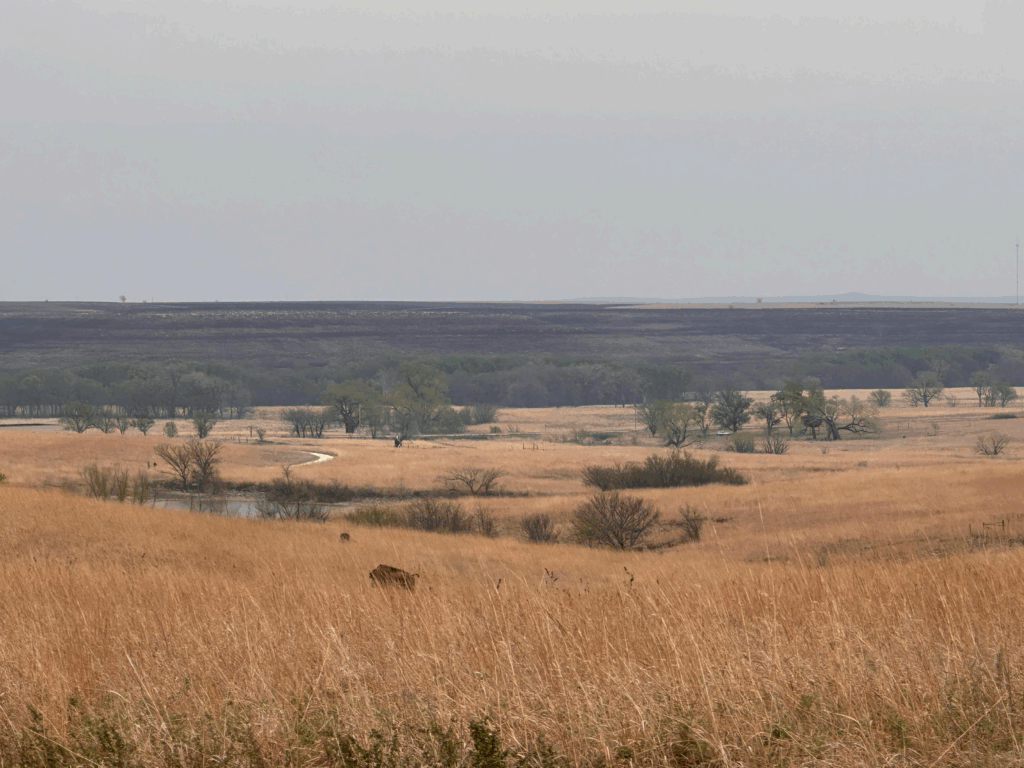
During Easter Break, my mom and I traveled south through Tornado Valley to explore some of the most iconic and lesser-known historic and natural sites in the central part of the U.S. Our journey would take us through Kansas and Oklahoma, visiting eight locations within the National Park System.
Our first stop was Fort Larned, located six miles from Larned, Kansas, and just steps from the Santa Fe Trail. This is one of the best-preserved western forts, with wooden and adobe structures that served as homes for many, including soldiers, travelers, railroad workers, Buffalo Soldiers and Plains Indians. In fact, the fort was a gathering place for the Cheyenne, Arapaho, Plains Apache, Kiowa and Comanche tribes to negotiate the Medicine Lodge Treaties. Not far from the fort, across the border in Colorado, is the site of the Sand Creek Massacre, where the peace chief Black Kettle fled into Oklahoma.
As we continued our journey south into Oklahoma, we encountered some evening thunderstorms. The next morning, we visited the Washita Battlefield National Historic Site, where, according to park plaques, in 1869, Lt. Col. Custer received orders “to destroy their villages and ponies; to kill or hang all warriors, and bring back all women and children” from the nearby Cheyenne winter camps. Custer reported that his efforts were “crowned by a most complete and gratifying success… the bodies of 103 of their warriors… We destroyed everything of value to the Indians.” In addition, Custer and his men slaughtered 675 horses and took 53 women and children prisoners. Along the Washita, or Hoóxe’eo’hé’e, River, a tree stands bowed under the weight of prayer cloths placed there by American Indians.
Rural roads and country highways led us from there to Chickasaw National Recreation Area, nearly 10,000 acres of sprawling woodlands, rivers, lakes and freshwater springs that the nearby town of Sulphur is named after. The Travertine Nature Center is one of the most impressive visitor centers I have encountered. Perched above a small creek, it houses live specimens of local flora and fauna that visitors might see on their trip. Unfortunately, we could only spend a few hours in the recreation area, but its campgrounds, swimming spots and hiking trails are something I would love to explore again.
Despite the many families enjoying the sun in Chickasaw NRA, the downed trees and decimated homes are a stark reminder of the EF3 tornado that swept through Sulphur, Oklahoma, last April. We briefly followed the path of destruction as we drove away from the recreation area before taking a brief detour onto historic Route 66.
From there, we headed north back into Kansas to visit Fort Scott. Despite the exhibits describing the monotony of soldiers’ lives at this fort, it played a significant role in American history. From the Santa Fe Trail and Manifest Destiny to Bleeding Kansas, the Civil War, and railroad expansion, the fort gives a glimpse into the past, with each building preserved or restored to its original state. While viewing one of the officer’s rooms, my mom exclaimed, “That mattress looks like it might be from 1846!” The yellowed and wrinkled mattress had no reply to this comment.
In 1884, journalist D.W. Wilder wrote, “We ought to have saved a park in Kansas, ten thousand acres abroad—the prairie as it came from the hand of God, not a foot or inch desecrated by ‘improvements’ or ‘cultivation.’” Wilder’s dream came true with Tallgrass Prairie National Preserve, home to bison herds, 40 miles of trails and 10,894 acres of uninterrupted prairie. While visiting, we asked the park ranger on duty which trail to take to view the bison herds. After drawing a map for us, she added, “They’ve made me liars before.” Luckily, on that day, the bison were exactly where she suggested we go. Visitors must stay at least 100 yards away from the animals, but seeing them from that distance was magnificent. The preserve also features a historic limestone farmhouse and barn, offering insight into the daily lives of Kansas’s early ranchers.
Starting our day in 95-degree Oklahoma, we ended it in Topeka, Kansas, and woke up to a chilly 38 degrees. While in Topeka, we visited the Brown v. Board of Education National Historic Park. The visitor center, located within Monroe Elementary School, features exhibits that guide tourists through the Brown case and life during the Civil Rights Movement. As we were leaving the Brown v. Board NHP, a group arrived headed for Topeka’s Capitol building for a protest after their tour.
The last stop on our trip was the Harry S. Truman Historic Site in Independence, Missouri. The site includes the farm where Truman worked as a boy, his cousin’s house, and the home he shared with his wife, Bess. Led by a park ranger, tours of the house explain Truman’s life in the White House and at home with his family. The site also highlights the romance between Bess and Harry Truman, featuring letters exchanged between them, such as Harry’s 1911 letter in which he wrote, “I’ve been crazy about you ever since we went to Sunday school together.”
That was the final stop on our getaway with my mom and I returning to Omaha in time to visit family for Easter Sunday. This trip was filled with endless golden fields, great blue skies and rolling hills. The sites we visited told different stories from America’s past, whether it be on the western front or in a classroom.
